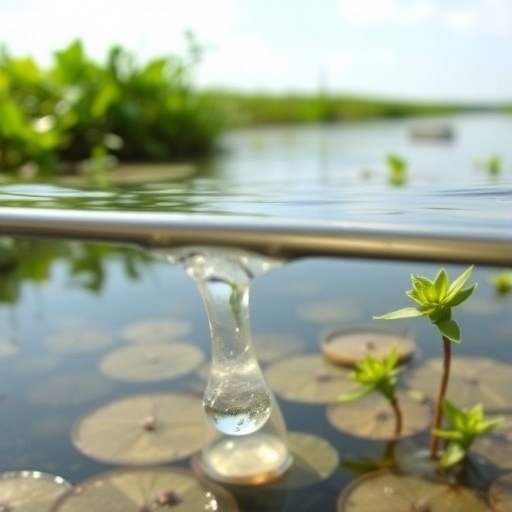
In a groundbreaking advance with the potential to revolutionize nutrient management and environmental remediation, researchers at North Carolina State University have engineered a novel hydrogel capable of selectively filtering phosphorus from contaminated waters. This innovative material not only efficiently captures phosphorus but also releases it gently and can be reused multiple times, addressing both ecological and economic challenges posed by current phosphorus recovery technologies. The breakthrough could mark a pivotal step toward sustainable phosphorus recycling, reducing reliance on finite mineral reserves while mitigating the severe water-quality issues caused by excess phosphorus.
Phosphorus is a vital nutrient extensively employed in agriculture as a key fertilizer ingredient, as well as in various industrial applications. However, the global supply of phosphorus is constrained by finite phosphate rock mining, an unsustainable source that raises concerns about long-term availability and environmental degradation linked to extraction activities. Paradoxically, excess phosphorus entering surface waters due to agricultural runoff, wastewater discharge, and other sources fuels eutrophication, a process that drives harmful algal blooms and oxygen-depleted “dead zones” in aquatic ecosystems. This dual challenge — phased reliance on scarce phosphorus reserves and environmental damage from phosphorus pollution — has motivated scientists to devise innovative recovery and reuse methods.
Existing phosphorus filtration technologies often involve the use of potent acids or bases to liberate captured phosphorus compounds, a process that introduces secondary environmental concerns and escalates economic costs. The treatment chemicals not only demand additional handling and neutralization but also impair the overall sustainability of phosphorus recovery methods. Against this backdrop, the new hydrogel system developed by the NC State team sidesteps the need for harsh reagents, unlocking a cost-effective and environmentally friendly pathway to phosphorus harvesting from water streams with minimal chemical input.
.adsslot_e3A2nMpJkP{width:728px !important;height:90px !important;}
@media(max-width:1199px){ .adsslot_e3A2nMpJkP{width:468px !important;height:60px !important;}
}
@media(max-width:767px){ .adsslot_e3A2nMpJkP{width:320px !important;height:50px !important;}
}
ADVERTISEMENT
The hydrogel’s architecture is constructed from two commercially available polymers: polyethyleneimine (PEI) and poly(methyl vinyl ether-co-maleic anhydride) (PMVEMA). PEI’s molecular structure provides a multitude of amine groups that are adept at binding phosphorus-containing species — particularly phosphate ions — as water traverses the material. Concurrently, PMVEMA interacts chemically with PEI, forming stable cross-links that yield a robust gel matrix. This durable yet permeable framework enables continuous flow-through filtering, preserving the integrity and functional capability of the hydrogel during repeated use, all at ambient temperatures.
Laboratory assessments revealed remarkable efficacy in phosphorus sequestration. The PEI/PMVEMA hydrogel demonstrated an ability to remove upwards of 90% of phosphorus from wastewater and contaminated surface water under realistic flow conditions at room temperature. Moreover, captured phosphorus could be released on demand employing only mild alkaline solutions, a significant advancement over previous methods reliant on more corrosive substances. This gentle release mechanism preserves the structural and chemical properties of the hydrogel, allowing it to be cycled multiple times with minimal loss in performance.
More impressively, the researchers showed that after three consecutive filtration cycles, the hydrogel maintained an outstanding 97.5% efficiency in phosphorus reuse. This recyclability not only enhances cost-effectiveness but also minimizes material waste and operational disruption. Economic projections put the cost of phosphorus removal by their hydrogel at approximately $23 per pound for single use; however, repeated application exponentially reduces this figure, with costs plummeting to below $0.50 per pound when utilized fifty times. Such affordability starkly contrasts with existing alternatives, which can range from $20 to $300 per pound of phosphorus removed, positioning this hydrogel as an attractive candidate for wide-scale implementation.
The environmental implications of this research are profound. By facilitating low-cost and sustainable phosphorus recovery from polluted water sources, the hydrogel technology presents an opportunity to close the nutrient loop — curbing phosphorus pollution while reclaiming this critical element for fertilizer and industrial reuse. This circular approach aligns with growing global emphasis on nutrient sustainability and combating eutrophication globally, potentially alleviating the burden on freshwater lakes, rivers, and estuaries affected by phosphorus loading.
The research team, led by co-corresponding authors Jan Genzer, S. Frank and Doris Culberson Distinguished Professor of Chemical and Biomolecular Engineering, and Kirill Efimenko, research associate professor at NC State, have already filed a provisional patent for the hydrogel material. They are actively seeking partnerships with industry stakeholders focused on environmental remediation, wastewater treatment, and agricultural innovations that can integrate this material into real-world applications. Their vision is to transition this laboratory innovation into scalable technologies that tangibly reduce phosphorus pollution and bolster phosphorus sustainability.
While current results underscore the hydrogel’s potential for waterborne phosphorus recovery, the team acknowledges that extending this technology to soil matrices presents more complex scientific challenges. Contaminated soils harbor phosphorus in various organic and mineral-bound forms, often within heterogeneous and less accessible microenvironments. Designing hydrogels or analogous materials that can effectively extract phosphorus from such media without compromising soil health remains an ambitious next frontier for the researchers.
Published in the journal Langmuir, the paper entitled “Functional Hydrogels for Selective Phosphate Removal from Water and Release on Demand” details the chemistry, performance benchmarks, and reusability tests behind this material. The study’s lead author, Jiangfeng Xu, alongside co-authors including Christopher Gorman, Yaroslava Yingling, and Lisa Castellano, collectively harnessed expertise across chemical engineering, materials science, and chemistry to achieve this interdisciplinary breakthrough. Funding support was provided by the National Science Foundation’s Science and Technologies for Phosphorus Sustainability (STEPS) Center, further highlighting the strategic priority of phosphorus sustainability in contemporary research.
This technology’s significance transcends academic curiosity, offering a scalable, sustainable, and economically viable solution to one of agriculture and environmental science’s most pressing dilemmas. As phosphorus demand is projected to rise with global population growth and intensifying food production, innovations like the NC State hydrogel stand ready to mitigate the environmental footprint of phosphorus use while ensuring nutrient availability for future generations. This convergence of material science and environmental engineering embodies a future where advanced polymers enable circular economies and healthier ecosystems.
The development of this hydrogel thus not only exemplifies a triumph in polymer chemistry and environmental technology but also signals a paradigm shift in how humanity manages essential but finite natural resources. By leveraging simple, cost-effective materials and benign chemistry, scientists have crafted a tool that promises both ecological restoration and economic advantage — a testament to the kind of innovation required for sustainable development in a changing world.
Subject of Research: Not applicable
Article Title: Functional Hydrogels for Selective Phosphate Removal from Water and Release on Demand
News Publication Date: 3-Jun-2025
Web References:
https://pubs.acs.org/doi/10.1021/acs.langmuir.5c00679
References:
Xu, J., Efimenko, K., Gorman, C., Yingling, Y., Castellano, L., Genzer, J. (2025). Functional Hydrogels for Selective Phosphate Removal from Water and Release on Demand. Langmuir. DOI: 10.1021/acs.langmuir.5c00679.
Keywords
Hydrogel, Phosphorus Removal, Phosphate Recovery, Water Treatment, Eutrophication, Sustainable Agriculture, Polymer Chemistry, Environmental Remediation, Nutrient Recycling, Polyethyleneimine, PMVEMA, Circular Economy
Tags: addressing eutrophication in water bodieschallenges in phosphorus recovery technologiescombating harmful algal bloomsenvironmental remediation strategiesimpact of agricultural runoff on water qualityinnovative hydrogel for water treatmentnutrient management in agriculturephosphorus removal technologyreducing reliance on finite mineral resourcesselective phosphorus filtration systemssustainable phosphorus recycling methodswater pollution mitigation techniques


